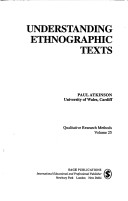Qualitative Research Methods
1 primary work
Book 25
Back to the basics. This is precisely what Paul Atkinson does for his readers in Understanding Ethnographic Texts, the first "how to" book of its kind. He provides basic, yet significant, lessons for ethnographers going about the business of writing up their findings. He uses the postmodernist premise that ethnography is not an unbiased, scientific view of "the field setting," but rather a construction of the ethnographer. From this, Atkinson offers useful advice on how to read, and then how to write ethnography. He explains the importance of self-consciousness in understanding how to present the material, how to develop story lines and use metaphor, how to organize material and create a voice, how to balance analysis with description, and how to use one′s own work in conjunction with others. He also outlines various literary conventions through recent experiments that have departed from traditional ethnographic style. He links these studies to an analysis of the contributions of postmodernist theory to ethnographic work, and then argues for the "authority" of the researcher, which contrasts the viewpoint of many postmodernist ethnographers. This highly accessible, "how to" book is readable, thoughtful, and instructive, and will prove invaluable to qualitative researchers, writing scholars, and text analysts, and to ethnographers in sociology and anthropology.
